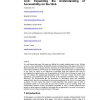Free Online Productivity Tools
i2Speak
i2Symbol
i2OCR
iTex2Img
iWeb2Print
iWeb2Shot
i2Type
iPdf2Split
iPdf2Merge
i2Bopomofo
i2Arabic
i2Style
i2Image
i2PDF
iLatex2Rtf
Sci2ools
W4A
2006
ACM
2006
ACM
How people use presentation to search for a link: expanding the understanding of accessibility on the web
It is well known that many Web pages are difficult for visually disabled people to use. Without access to a rich, visual display, the intended structure and organisation of the page is obscured. To fully understand what is missing from the experience of visually disabled users, it is pertinent to ask how the presentation of Web pages on a standard display makes them easier for sighted people to use. Here, we report on an exploratory eye-tracking study that addresses this issue by investigating how sighted readers use the presentation of the BBC News Web page to search for a link. We compare the standard page presentation with a “text-only” version and observe both qualitatively and quantitatively that the removal of the intended presentation alters “reading” behaviours. The demonstration that the presentation of information assists task completion suggests that it should be re-introduced to non-visual presentations if the Web is to become more accessible. We also explore the e...
| Added | 14 Jun 2010 |
| Updated | 14 Jun 2010 |
| Type | Conference |
| Year | 2006 |
| Where | W4A |
| Authors | Caroline Jay, Robert Stevens, Mashhuda Glencross, Alan Chalmers |
Comments (0)

